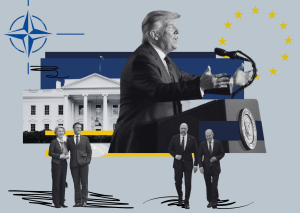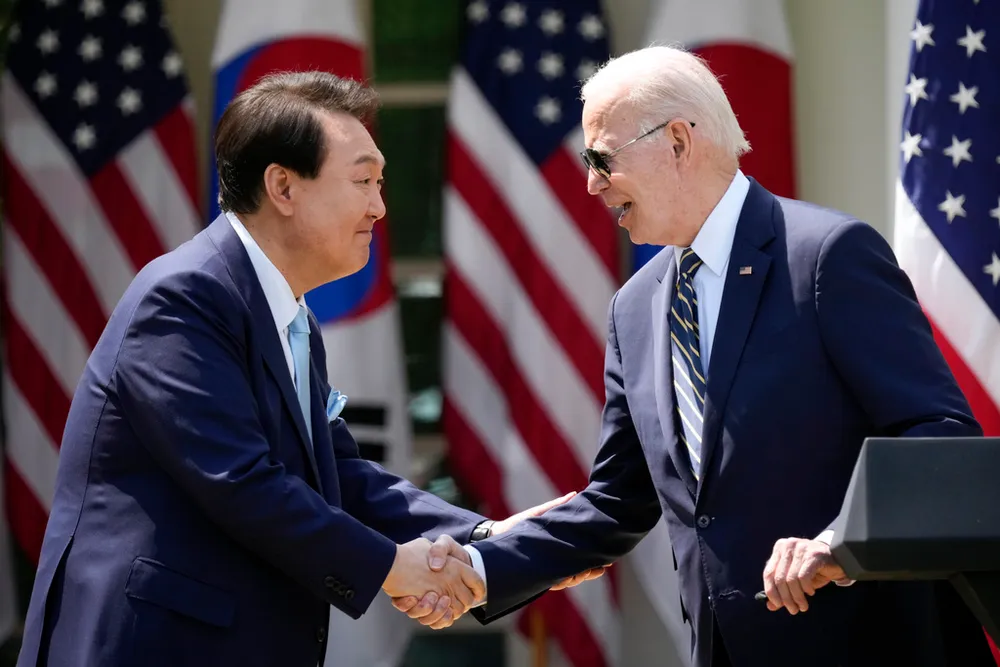
The US and South Korea strengthen their alliance and regional security through the Washington Declaration, aiming to bolster cooperation against nuclear threats and deepen strategic partnerships.
APRIL 25, 2024

One year ago on April 26th 2023, the United States and Republic of Korea released the Washington Declaration, a landmark joint statement which commemorates the 70th anniversary of the U.S. ROK alliance and reaffirms the security partnership between the two allies. In the statement, the ROK expressed its full confidence in the U.S. nuclear umbrella and its continued reliance on the U.S. nuclear deterrent. For its part, the United States reaffirmed its commitment to extended deterrence and to exercising the “full range” of U.S. capabilities in response to a DPRK nuclear attack.
The statement emerged at a key time when anxieties were mounting over North Korea’s intensifying nuclear threats and amid an evolving security environment on the Korean Peninsula. One key development was North Korea’s adoption of a first use nuclear doctrine. In a law passed on September 8th 2022, North Korea formalized its possession of nuclear weapons (with Kim Jong Un stating that its nuclear status “has now become irreversible”) and laid out circumstances under which it would use nuclear force. The two conditions under which nuclear weapons can be used were identified as 1) in case of an impending attack on strategic assets including leadership; and 2) in case of a need for “taking initiative in war.” The use cases outlined amounted to giving the DPRK a green light for nuclear first use against a non-nuclear weapon state and to launch nuclear weapons preemptively. The DPRK also launched more than 30 ballistic missiles in the year 2022 and continued launching at a similar pace in the months leading up to Yoon’s State Visit, the diplomatic summit which resulted in the declaration.
Public opinion of South Koreans at the time also demonstrated that an ever increasing majority of people favor domestic nuclear armament. A 2022 poll by the Chicago Council on Global Affairs revealed that upwards of 70% of South Koreans wanted their country to develop its own nuclear weapons. The U.S. is firmly opposed to nuclear armament for South Korea given the security dilemma and nuclear domino implications for the Northeast Asian region, as well as the major challenge it would pose to the NPT-based global nonproliferation regime.
It was against this backdrop of increased tension on the peninsula and concerns over the reliability of the U.S. nuclear umbrella that the US and ROK came together to produce the Washington Declaration. Aside from reaffirming commitments, the declaration also announced the creation of the Nuclear Consultative Group (NCG), a regularly convening bilateral consultation mechanism that focuses on nuclear and strategic planning issues. While it falls short of something like nuclear sharing which the U.S. engages in with NATO countries, the NCG more concretely integrates South Korea into U.S. planning and decision-making for contingencies on the Korean Peninsula that might necessitate nuclear use. The U.S. also pledged to more visibly deploy nuclear capable assets to the region in order to directly telegraph its commitment to deterrence. In exchange, South Korea under the Yoon government agreed to not pursue its own nuclear weapons.
In the year since the Washington Declaration was announced, how has the alliance been fairing towards putting into action the goals and ideals set out in the statement?
The NCG met twice in 2023, once in July in South Korea and once in December in the United States. The July 2023 meeting coincided with a visit of the USS Kentucky, an Ohio-class ballistic missile submarine, to the port in Busan. At the inaugural NCG meeting, the U.S. further reaffirmed and strengthened its extended deterrence commitment to the ROK. Both sides established a “range of workstreams” through which the NCG would bolster nuclear deterrence and response capabilities between the two allies. This includes 1) mechanisms for security in information sharing; 2) nuclear consult and crisis communication processes; 3) coordination on training, planning, simulations; and 4) joint planning of South Korean conventional support to U.S. nuclear operations (CNI). The commitment to further quarterly meetings of the NCG was also reiterated.
The second NCG meeting convened in December 2023 in Washington D.C. In a statement, both sides reported a deepening of cooperation on deterrence between the U.S. and ROK via the NCG working Group workstreams, including on U.S.-ROK conventional and nuclear integration, strategic communication, and risk reduction practices. The NCG Principals discussed future plans to demonstrate strengthened deterrence through further strategic asset deployment, building on the ballistic missile submarine visit, strategic bomber flyover, and ICBM test launch joint observation from earlier that year.
So far, the follow-up to the Washington Declaration has seemed to meet the expectations set in the document. Both sides are taking clear steps to shore up cooperation on extended deterrence and South Korea has been integrated into information sharing and decision making in numerous concrete ways. Crucially, the Washington Declaration and follow-up measures have helped to calm the stressors leading South Korea to float the idea of an independent nuclear capability or redeploying U.S. tactical nuclear weapons, arguments that had more often slipped into the mainstream discourse previously. The NCG has helped to address a key credibility issue that existed with U.S. extended deterrence by providing South Korea with a say into planning rather than offering up the nuclear umbrella under “take it or leave it” terms. Further work via the NCG should do more to eliminate the credibility gap by ensuring that both sides feel that planning and implementation is being done in a joint manner.
Additionally, securing a firm commitment from the ROK to rely on U.S. extended deterrence and not pursue its own nuclear capability was a major achievement of the Washington Declaration towards upholding NPT norms, and it raises another barrier against Seoul attempting to toy with that course of action in the future. South Korea also wins from this by bolstering the impression that it is a responsible member of the international community in spite of strong domestic pressures, something that will be increasingly important as it tries to live up to the “global pivotal state” vision.
While undeniable progress has been achieved through the NCG meetings, worrisome challenges still lie ahead. In remarks at an event this past New Year’s, Kim Jong Un announced changes to policy and government organizations which would see South Korea treated as a separate, enemy state. These changes have been interpreted as potentially making it easier for North Korea to justify the use of nuclear weapons against Seoul in a conflict. This policy change could be a prelude to a period of more intense weapons testing and vitriol out of the DPRK, especially as the 2024 Presidential Election in the United States looms large. More bombastic rhetoric and missile launches could put more domestic pressure on the ROK government via a renewal of calls for nuclear armament, a scenario that is quite likely considering that support for nuclear armament has not shown any signs of subsiding in recent polling.
While redeploying tactical nuclear weapons or pursuing an independent nuclear capability might not make sense under a Biden presidency, it’s easy to see why the calculations of defense strategists in Seoul might drastically change in the event that the “America First” President returns to the White House. During his time in office, Donald Trump viewed the U.S.-ROK alliance in transactional, often myopic, financial terms, and as a candidate he even expressed openness to allowing South Korea to build its own nuclear weapons (while withdrawing U.S. troops). It may be wise for the Biden administration and allies in congress to pursue a legislative deal that codifies the principles of the Washington Declaration and insulates the important work of the NCG from being meddled with by an executive without the input of congress.
In terms of addressing the persistent high levels of support for nuclear armament among the public, it will be necessary for the Biden and Yoon government to work together to create a messaging strategy that reassures the public of the shared commitment to extended deterrence. The continued visible deployment of nuclear triad assets through joint exercises could also help quell these sentiments at the margins over time. It should be noted that, beyond providing credible extended deterrence, there is only so much that can be done to reassure the South Korean public from the perspective of the United States, given that survey research has identified that a significant motivating factor for support for nuclear armament is a desire for “global prestige.”
The third NCG Meeting, planned for this June, will be led by the ROK defense ministry and the Pentagon which are expected to discuss a shared nuclear strategy to deter nuclear threats from the DPRK. Officials at the meeting are anticipated to draw up additional guidelines for nuclear crisis consultation procedures, information sharing, security systems, and for operating a leader-level communication channel. These will be put to the test during the joint Ulchi Freedom Shield exercise in August.
Going forward, one key area that the allies should focus on through the NCG framework is cooperation on conventional nuclear integration. The task of coordinating two militaries with mixed conventional and unconventional capabilities to maintain extended deterrence is a highly difficult one, and it can be easily complicated by mixed messaging from leadership on both sides. Messaging about the timing and scale of a hypothetical nuclear retaliation needs to be further synchronized between the allies, as Yoon and Biden have at times deviated from one another on this front.
Further, while South Korea’s perception of alliance dynamics may be born out of a concern of entrapment when considering contingencies such as conflict over Taiwan, that could quickly shift to fears of abandonment in a context where a DPRK strategic nuclear strike on the U.S. mainland is on the table (especially under a Trump Presidency). Enhanced cooperation on CNI would help bolster U.S. assurances to the ROK if Washington’s nuclear posture was brought further into line with the ROK’s conventional posture. The allies should focus on ensuring that their joint forces can operate in an environment that has already escalated beyond limited nuclear use, and clearly signal this capability to North Korea.
The thorny geopolitical landscape on the Korean Peninsula requires that both allies remain committed to sustained cooperation via the NCG and its working group/associated workflows under the Washington Declaration framework. As the U.S. and ROK jointly confront a nuclear armed North Korea, disincentivizing nuclear use becomes increasingly important. While challenges exist in the form of domestic pressures for nuclear armament in South Korea and the prospect of a 2nd Trump Presidency, the concrete credibility enhancements to extended deterrence achieved through the NCG should help to insulate it from any partisan efforts to dismantle it. On the U.S. side, codifying the NCG and the principles of the Washington Declaration through legislative means could ensure that it continues to play a central role in maintaining extended deterrence.
A curated seletion of FA’s must-read stories.
Written By: SeungHawn Kim
Written By: RIZWAN RAFI TOGOO
Written By: MARCO MENDEZ
Written By: KRISHNA ACHNAF HERINDRA
Written By: BILLY AGWANDA
Written By: SURUTHI LENIN
Written By: BERK TUTTUP
Written By: ALEXANDER BERGH

Chris Gowe is an American MA candidate at the Seoul National University Graduate School of International Studies. His research interests include U.S. ROK Alliance dynamics and security / proliferation issues pertaining to North Korea and the greater Northeast Asian region. He is also a Project Assistant with the Korea On Point publication and previously worked as a research intern at the Asia Pacific Leadership Network for Nuclear Non-proliferation and Disarmament.
Written By: BATUHAN GUNES
Written By: KRISTIN HYNES
Written By: ERIC SONG
Written By: ALEXANDER BERGH
Written By: KATE-REID SMITH
Written By: JOSEF SCHOEFL
Written By: PATRIC MCFARLAND
Written By: FATIH CEYLAN
FA’s flagship evening newsletter guilding you through the most important world streis ofthe day. Delivered weekdays.
